In the early 1980s, I can clearly remember
one day when my Father returned from work and presented a strange object to the
family. It was made of plastic, rectangular in shape and coloured black with a
yellow strip running around the edge. We couldn’t guess what it was (we weren’t
allowed to touch it!), so he put us out of our misery by proudly flipping open
the hinged top to reveal a lit bulb. It was a torch, but unlike any we had seen
before and operating in a completely different way (no on/off switch, you
simply opened/closed the pivoting lid). We were specifically instructed that we
could not play with it - this was NOT a toy - which was a shame as I found
it fascinating and was already imagining using it as some sort of Blake’s 7 futuristic
teleportation device.
 |
Image ref: The pocket-sized Durabeam
torch. Image credit: Katherine Pell |
The reason this childhood recollection was prompted was due to a recent enquiry we had received at MoDiP, from a woman still using her Durabeam torch all these years later. It had stopped working but she had forgotten how to change the batteries and sought our help. We were able to assist her with full instructions on how to remove the side panel in order to access the battery compartment.
 |
Image ref: The side panel removed to
access the batteries. Image credit: Katherine Pell |
MoDiP has two examples of the Durabeam torch in both the small and larger size.
 |
The Durabeam was designed in 1982 by R.J. Winstone, A. Forman, P.J. Pope and J. Drane of BIB Design Consultants, a company formed by Nick Butler, Peter Isherwood and Stephen Bartlett in 1967. Duracell UK Ltd, a subsidiary of the US battery manufacturer, wanted to enhance the sale of their batteries within Europe (at that time they held a 25% market share). They conducted extensive consumer research for products that used batteries and ultimately identified the potential for manufacturing a small, portable torch that could provide the solutions to those aspects that customers were currently unsatisfied by. For example, people often needed their hands free to tackle a job but found they had to hold the torch to direct the beam. The on/off switch was often found to be unreliable and a common complaint was that the lens would break easily.
As a one product company (ie. alkaline batteries), Duracell had no internal design department so they invited three industrial design agencies to submit proposals for this new torch. BIB were successful, answering the brief with early concept sketches that illustrated distinctive geometric forms, using only the Duracell corporate colours of black and yellow.
 |
|
In an interview published in 1984, Nick Butler said:
'Duracell were enlightened clients – they’d never made anything but batteries before. We knew that play value was important: kids like to read comics with torches. We also knew that no designer had yet done a good torch. The brief was to sell batteries, so the solution had to be cheap. We thought go for a light source, not a torch.’
It was this thinking that allowed the design to develop in such a different way to traditional torch forms and an idea that Duracell were particularly keen to adopt was the articulated head. John Drane prototyped the mechanism, applying various pressures through a process of trial and error to achieve the correct ratchet strength. Other design modifications included simplifying the battery cover to snap fit over pegs moulded into the body, thereby reducing mould tooling costs, and the black coloured external surfaces being given a matt finish to disguise imperfections caused by uneven shrinkage in the acrylonitrile butadiene styrene (ABS) material selected.
The final robust
product was launched
in two sizes (home and pocket), priced slightly higher than its competitors but
with batteries included so the product was ready to work immediately. It was
also the first torch to be advertised and a contemporary report records how people
were coming into the shops with magazine cuttings to specifically seek out the
Durabeam. Released in the UK in September 1982, 450,000 torches were sold in
the first three months with sales achieving over 3 million just two years later.
 |
Image ref: 1980s advert: it stands up, lies down,
bends over backwards, and then completely disappears. Image credit: https://www.hatads.org.uk/catalogue/record/09d13feb-a89a-4180-b352-fa2b846837b0 |
Awarded a Design Council award for Design Excellence in Consumer and Contract Goods: Durable Products, 1984, the awards judging panel commented that 'Durabeam is a compelling product - one wants to hold it, use it, buy it, which is after all essential to good design'.
Katherine Pell
Collections Officer
Collections Officer
References:


No comments:
Post a Comment
Note: only a member of this blog may post a comment.